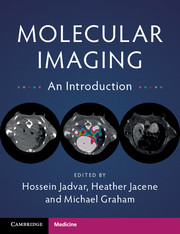Book contents
- Frontmatter
- Contents
- List of Contributors
- Preface
- 1 Instrumentation – CT
- 2 MRI/ MRS Instrumentation and Physics
- 3 Optical and Ultrasound Imaging
- 4 Instrumentation-Nuclear Medicine and PET
- 5 Quantitation-Nuclear Medicine
- 6 Perfusion
- 7 Metabolism
- 8 Cellular Proliferation
- 9 Hypoxia
- 10 Receptor Imaging
- 11 Apoptosis
- 12 Angiogenesis
- 13 Reporter Genes
- 14 Stem Cell Tracking
- 15 Amyloid Imaging
- Index
- References
Preface
Published online by Cambridge University Press: 22 November 2017
- Frontmatter
- Contents
- List of Contributors
- Preface
- 1 Instrumentation – CT
- 2 MRI/ MRS Instrumentation and Physics
- 3 Optical and Ultrasound Imaging
- 4 Instrumentation-Nuclear Medicine and PET
- 5 Quantitation-Nuclear Medicine
- 6 Perfusion
- 7 Metabolism
- 8 Cellular Proliferation
- 9 Hypoxia
- 10 Receptor Imaging
- 11 Apoptosis
- 12 Angiogenesis
- 13 Reporter Genes
- 14 Stem Cell Tracking
- 15 Amyloid Imaging
- Index
- References
Summary
Since the discovery of x-ray by Wilhelm Röntgen at the turn of the twentieth century, there have been monumental strides in the ability to image biological processes in health and in disease. Imaging has not only improved our understanding of the complex and dynamic underpinnings of disease but it has also entered the center of patient care for many conditions. Molecular imaging is a relatively recent term that has been coined in the world of imaging science. The Society of Nuclear Medicine and Molecular Imaging (SNMMI) formed a task force in 2007 to develop standard definitions and terms to serve as the foundation of all communications, advocacy, and education activities in molecular imaging. The task force recommended and the SNMMI board approved the following definition for molecular imaging (1):
Molecular imaging is the visualization, characterization, and measurement of biological processes at the molecular and cellular levels in humans and other living systems. Molecular imaging typically includes 2- or 3-dimensional imaging as well as quantification over time. The imaging techniques may include radiotracer imaging/nuclear medicine, MR imaging, MR spectroscopy, optical imaging, ultrasound, and others.
The task force further elaborated that
molecular imaging has relevance for patient care: it reveals the clinical biology of the disease process; it personalizes patient care by characterizing specific disease processes in different individuals; and it is useful in drug discovery and development.
There are a few comprehensive books now available for detailed descriptions of methods and applications in molecular imaging. The aim of this book is to provide a brief introduction to the world of molecular imaging. It is not intended to provide an exhaustive list of all available or potential imaging techniques or methods, but major modalities and applications are included. The book will be useful for students, physicians in training, and others who desire to grasp the basic concepts of molecular imaging in an efficient manner in a relatively short time.
The book is organized by introduction of instrumentation, physics and methods of various imaging modalities, followed by several key biological processes that may be interrogated with molecular imaging. In each chapter, the brief discussion is followed by a bibliography, which may be referred to for additional information and a more in-depth understanding of the topic.
- Type
- Chapter
- Information
- Molecular ImagingAn Introduction, pp. ix - xPublisher: Cambridge University PressPrint publication year: 2017



